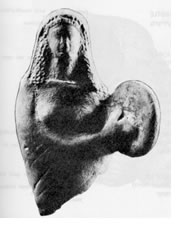Volume. XX, No. 3 From the pastorÆs heart: Drums in the BibleOnce after we are convinced that music is not neutral and has enormous influences on our mind and behaviour, the next question we begin to ponder on is of musical instruments. Music is not just an arrangement of notes. Music includes its style and instrument it uses. If we want to maintain good quality church music, what kind(s) of musical instruments should we use? Or, more specifically, what kind of instruments do we prefer for our music? When we study on this topic, we go back to the Old Testament to find a list of musical instrument. Music is a part of the culture of ancient Israel. In the Old Testament, music has played a very important role in the life of the children of Israel, socially, culturally, and religiously. Music is an expression of joy and sorrows. Music expresses thanksgiving and victory. Even without apparent preparations ahead, music often springs out spontaneously. There are many musical instruments used in temples services, festivals, weddings, or funerals. One difficulty to study on this subject is that there are not specific descriptions of these instruments except their names. Therefore, sometimes we may have to depend on archaeological discoveries from neighbouring countries. There are advantages and disadvantages in this approach. One obvious disadvantage is that we cannot be 100% sure of the shapes of the Israelis’ musical instruments (not all of them, but some). One obvious advantage is that we can have some rough ideas about types or shapes of musical instruments by analogy. There are basically three types of musical instruments in the Bible: percussive, wind and string instruments. I think that there are lots of interests about percussive instruments including drums. The most primitive musical instruments may be percussive, it is worth noting that the first two instruments mentioned in the Bible are not percussive. Genesis 4:21 says, “And his brother’s name was Jubal: he was the father of all such as handle the harp and organ.” In fact, this verse has been used against the use of any kind/type of musical instrument in the church by some Christians. They have argued that the inventor of music was a descendent of Cain, a wicked and evil man, who was his brother’s murderer. Therefore, the use of musical instrument is evil. However, I think that there are a couple of inherent problems with this interpretation. First, Genesis 4:20 says, “And Adah bare Jabal; he was the father of such as dwell in tents, and of such as have cattle.” Jabal was a descendent of Cain, too. I do not think that it means that it was sinful for a man to live in a tent and to have cattle (or eat them). Abraham, Isaac, and Jacob were all herdsmen who lived in tents. Second, God ordered Moses to make musical instruments, for example, in Numbers 10:1-10 (in this case trumpet). Out of all these instruments, it seems that we pay attention to percussive
instruments the most. It may be the use of drums in churches. In the past,
drum was one of those taboos in Christian churches and had been considered
as a champion of all secular music. However, nowadays it becomes a fad to have
one, not just simple one but very elaborated one. If a church has a drum set,
it is regarded as a contemporary church, which is not outdated. Let me begin
with percussive instruments first to satisfy your curiosities. David Campbell
wrote an article about musical instruments in ancient Israel for the University
of Texas at Austin website (more).
He said, “The Hebrew term, tof, encompasses most of the percussion instruments
in Israel during the Iron Age. Tof probably refers to various hand-held drums
and tambourines.” It is clear that there were various types of drums
and tambourines. This particular Hebrew word has been understood as tambourine,
timbrel or tabret. A few biblical examples are as following: The modern tambourine is a jingle percussion instrument. It usually does not have a skin with a frame of crescent or half circle shape. However, the tambourine in the Old Testament is “the timbrel of hand-drum” which consists of a “broad or narrow hoop of wood or metal over which the skin of an animal is stretched.” “The instrument is held high in one hand, while the performer beats on the drumhead with the fingers and the back of the other hand. The form of the instrument is similar to that of the modern tambourine, as is also the manner of playing on it. . . . The tambourine apparently had no place in the Temple service, however; at least in the enumeration of the instruments of the Temple orchestra (II Chron. v. 12 et seq.)” (more). One thing is for sure that drum or tambourine in the Bible is not the same as drums we are familiar with. The following pictures will help us understand the kind of drum we are talking about from the Bible.
The drums in the Bible are small and played by hands. Mostly women played them. They were not used in temple worship. Therefore, it is not appropriate to use Old Testament references to justify the use of drums in churches today. Lovingly, |
|
 This picture is Woman with a timbrel. Pottery figurine. Achziv, Iron Age II.
(Gorali, 35). As far as I know, there has been no drum recovered. However,
a few pottery figurines like the one in the picture have been found.
This picture is Woman with a timbrel. Pottery figurine. Achziv, Iron Age II.
(Gorali, 35). As far as I know, there has been no drum recovered. However,
a few pottery figurines like the one in the picture have been found.